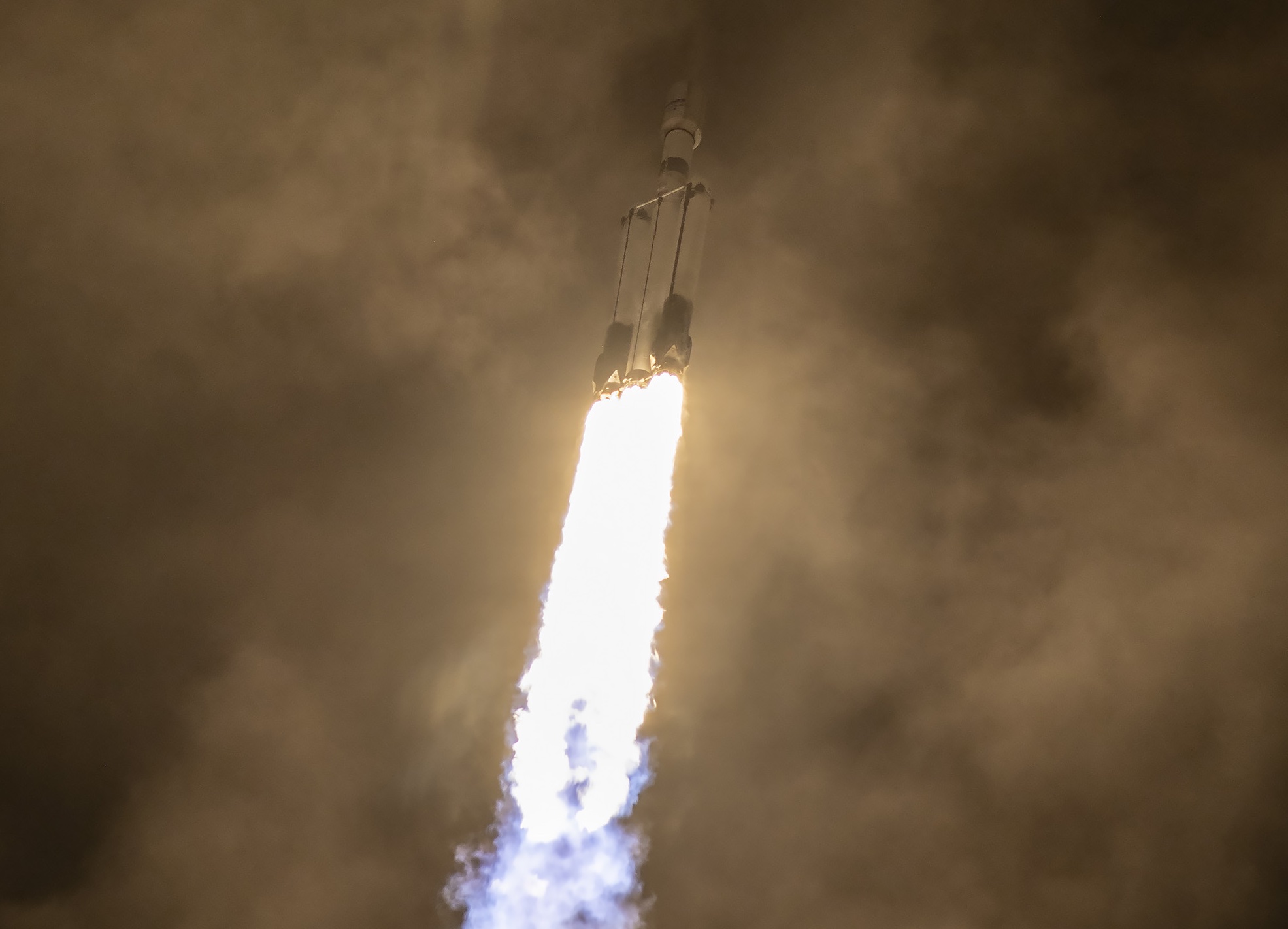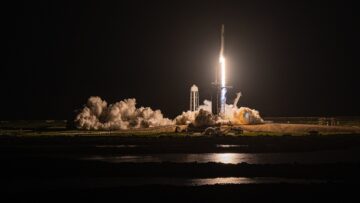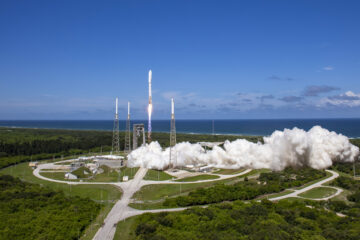
TAMPA, Fla. — SpaceX launched EchoStar’s more than nine metric ton Jupiter-3 spacecraft July 28 and successfully dropped off the world’s heaviest commercial communications satellite in geosynchronous transfer orbit.
The Maxar Technologies-built satellite lifted off on a dedicated Falcon Heavy at 11:04 p.m. Eastern from Kennedy Space Center, Florida, separating from the rocket about three and a half hours later.
Both Falcon Heavy side boosters landed at nearby Cape Canaveral Space Force Station just over seven minutes after launch for reuse. They had supported two earlier Falcon Heavy missions, both for the U.S. Space Force: USSF-44 in November and USSF-67 early this year.
The mission was delayed from July 26 to allow more time for vehicle checkouts after an abort was called with about a minute remaining in the countdown for reasons SpaceX did not detail.
EchoStar’s Hughes Networks Systems subsidiary, which is set to provide Jupiter-3’s broadband services, confirmed the satellite has started sending and receiving its first signals post-launch, and that engineers had deployed its solar arrays.
Jupiter-3 is set to double the capacity of the operator’s Jupiter fleet with an additional 500 gigabits per second, after reaching its 95 degrees west orbital slot and completing health checks the operator expects to wrap up in the fourth quarter.
The broadband services would address rising demand over the Americas, where it has been losing subscribers as capacity constraints weigh on the business.
EchoStar recently said Hughes broadband subscribers are using about 15% more bandwidth on average year-on-year amid intensifying competition in the market, including from SpaceX’s Starlink broadband constellation.
Jupiter-3 enables the company “to start growing again in our key markets where we’ve been hesitant to add new customers because of the capacity limitations,” EchoStar chief operating officer Paul Gaske said, “and it also allows us the opportunity to improve plans for our existing customers.”
He said the company has a number of “pinch points” to address but its constraints are highest in the United States, where it intends to put the largest chunk of Jupiter-3’s capacity to work.
Heavyweight champions
EchoStar ordered Jupiter-3 (also called EchoStar-24) in 2017 from Space Systems Loral before it rebranded as Maxar Technologies, and had initially planned to launch it in 2021 before the pandemic led to production issues at Maxar and other satellite manufacturers.
Maxar said Jupiter-3, at about the size of a standard school bus when antennas and solar panels stowed and with a wingspan of a Boeing 737 when fully deployed, is the largest spacecraft it has ever made.
Jupiter-3 unseats Telesat’s Telstar-19 Vantage that launched in 2018 on a SpaceX Falcon 9 as the largest commercial communications satellite ever deployed.
Maxar-built Telstar-19 Vantage had a launch mass of roughly seven metric tons.
Heaviest commercial communication satellites
| Satellite | Manufacturer | Launch Mass (kg) | Launch Vehicle | Launch Date |
| Jupiter-3 | Maxar Technologies | 9,200 | SpaceX Falcon Heavy | July 28, 2023 |
| Telstar-19 Vantage | Maxar Technologies | 7,076 | SpaceX Falcon 9 | July 22, 2018 |
| Telstar-18 Vantage | Maxar Technologies | 7,060 | SpaceX Falcon 9 | September 10, 2018 |
| SXM-7 | Maxar Technologies | 7,000 | SpaceX Falcon 9 | December 13, 2020 |
| SXM-8 | Maxar Technologies | 7,000 | SpaceX Falcon 9 | June 6, 2021 |
Jupiter-3 was deployed on the third Falcon Heavy of 2023, coming after its April 30 launch for primary passenger ViaSat-3 Americas, a 5.6 metric ton satellite operated by EchoStar broadband rival Viasat that later suffered an antenna anomaly.
Arcturus, the first satellite built by Astranis that was also on the flight with a mass of around 400 kilograms, suffered an unrelated post-launch issue that means it will not provide broadband over Alaska as planned.
The mission for Jupiter-3 was Falcon Heavy’s seventh flight since its debut in 2018. It was SpaceX’s 51st launch mission so far this year.
Related
- SEO Powered Content & PR Distribution. Get Amplified Today.
- PlatoData.Network Vertical Generative Ai. Empower Yourself. Access Here.
- PlatoAiStream. Web3 Intelligence. Knowledge Amplified. Access Here.
- PlatoESG. Automotive / EVs, Carbon, CleanTech, Energy, Environment, Solar, Waste Management. Access Here.
- BlockOffsets. Modernizing Environmental Offset Ownership. Access Here.
- Source: https://spacenews.com/falcon-heavy-sends-jupiter-3-broadband-giant-toward-geostationary-orbit/
- :has
- :is
- :not
- :where
- ][p
- $UP
- 10
- 11
- 13
- 15%
- 2017
- 2018
- 2021
- 2023
- 22
- 26
- 28
- 30
- 500
- 9
- a
- About
- add
- Additional
- address
- After
- again
- alaska
- allow
- allows
- also
- Americas
- Amid
- an
- analysis
- and
- antenna
- April
- ARE
- around
- AS
- At
- available
- average
- Bandwidth
- because
- been
- before
- Boeing
- BOOSTERS
- both
- broadband
- built
- bus
- business
- but
- by
- called
- Capacity
- Center
- Checks
- chief
- Chief Operating Officer
- coming
- commercial
- Communication
- Communications
- company
- competition
- completing
- CONFIRMED
- constraints
- countdown
- credit
- Customers
- data
- debut
- dedicated
- Delayed
- Demand
- deployed
- detail
- DID
- double
- dropped
- Earlier
- Early
- eastern
- enables
- Engineers
- EVER
- existing
- expects
- falcon
- Falcon 9
- far
- First
- flight
- florida
- For
- Force
- Fourth
- from
- fully
- giant
- Growing
- had
- Half
- Health
- heavy
- Hesitant
- highest
- HOURS
- HTTPS
- improve
- in
- included
- Including
- information
- initially
- intends
- intensifying
- issues
- IT
- ITS
- jpg
- July
- Jupiter
- just
- Key
- largest
- later
- launch
- launched
- Led
- Lifted
- limitations
- losing
- made
- Manufacturers
- Market
- Markets
- Mass
- McKinsey
- means
- metric
- minute
- minutes
- Mission
- missions
- more
- networks
- New
- no
- number
- of
- off
- Officer
- on
- operated
- operating
- operator
- Opportunity
- Orbit
- Other
- our
- over
- pandemic
- panels
- Paul
- per
- planned
- plans
- plato
- Plato Data Intelligence
- PlatoData
- post-launch
- primary
- Production
- provide
- publicly
- put
- Quarter
- reaching
- reasons
- receiving
- remaining
- reuse
- rising
- Rival
- rocket
- roughly
- s
- Said
- satellite
- School
- Second
- sending
- sends
- separating
- Services
- set
- seven
- side
- signals
- since
- Size
- slot
- So
- so Far
- solar
- solar panels
- sourced
- Sources
- Space
- Space Force
- spacecraft
- SpaceX
- standard
- starlink
- start
- started
- States
- station
- subscribers
- subsidiary
- Successfully
- suffered
- Supported
- Systems
- Technologies
- than
- that
- The
- they
- Third
- this
- this year
- three
- time
- to
- Ton
- tons
- toward
- transfer
- two
- u.s.
- U.S. Space Force
- United
- United States
- us
- using
- vehicle
- was
- weigh
- West
- when
- which
- will
- with
- Work
- world’s
- would
- wrap
- year
- zephyrnet











